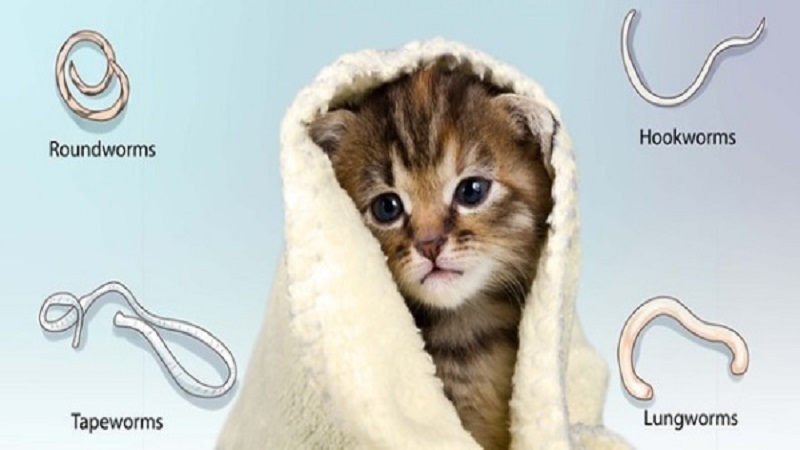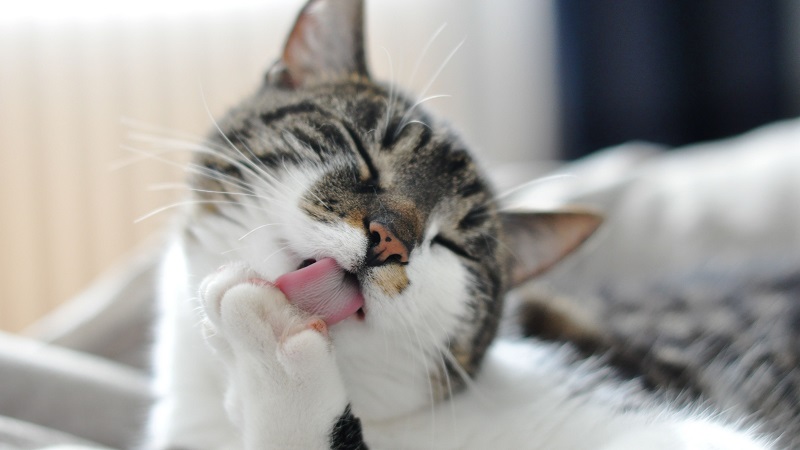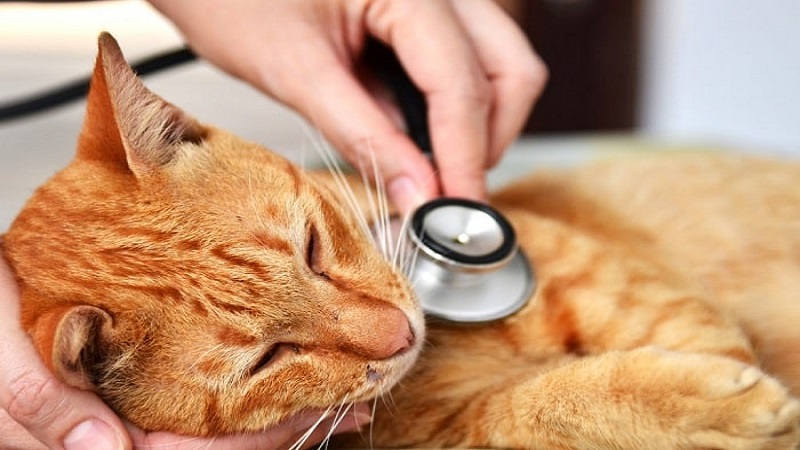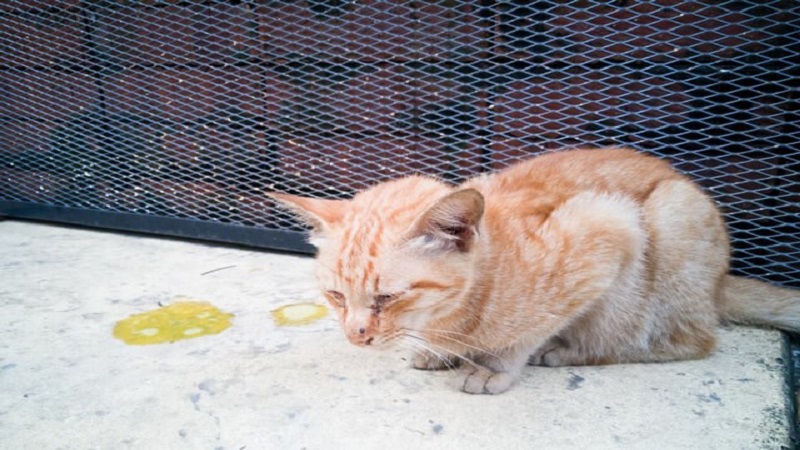After a long and tiring day at work and the pressures of life, it’s wonderful to come home to a furry friend who’s always there to share and comfort you. We keep pets not to serve our whimsical hobbies but to share responsibilities and help us find balance in life. So, let’s explore various cat ailments, their causes, symptoms, and treatments together.
1 Fungal Infection in Cats
Cats can get fungal infections due to a lack of warmth, inadequate drying after baths, playing in dirty environments, and insufficient hygiene. Damp environments can also contribute to this issue.
When a cat has a fungal infection, it typically experiences itching, discomfort, and hair loss in patches. These patches may form scales, emit a foul odor, and cause skin irritation and redness. If left untreated, the infection can spread across the cat’s body, affecting the entire litter and even transmitting to humans.
 Cat with a fungal infection
Cat with a fungal infection
To control the infection, quickly shave the affected area to prevent widespread transmission, and apply topical antifungal treatments such as Nizoral, Kentax, Ketoconazole, Fungikur, Biopirox, or Oxyd zinc ointment. For severe cases, combine the topical treatment with oral medication and liver supplements to enhance the treatment’s effectiveness, and consult a veterinarian for the best care.
For further reference:
2 Flea Infestation in Cats
Flea infestations in cats are caused by the saliva of fleas and not their bites. Flea saliva contains proteins that trigger allergic reactions, and when these reactions are excessive, they lead to inflammation. This condition causes intense itching, leading to excessive grooming, hair loss in patches, skin thickening, swelling, and scaling.
 Fleas on a cat
Fleas on a cat
The simplest solution to flea-induced inflammation is to get rid of the fleas. Various methods can be employed, such as topical, spray, or spot-on treatments, as well as flea collars or oral medications. For more severe cases, it is advisable to consult a veterinarian for proper treatment.
For further reference: Important considerations in caring for newborn kittens.
3 Worms in Cats
There are numerous ways for worms to enter a cat’s body, including ingesting worm eggs from the mother’s milk, direct skin penetration by hookworms in older cats, and tapeworms transmitted by fleas, rabbits, or infected rodents.
 Worms in a cat’s stool
Worms in a cat’s stool
Since worms reside inside the body, they can be challenging to detect. However, some signs to look out for include the presence of worms in the cat’s stool, fatigue, weakness, loss of appetite, excessive eating without weight gain, and prolonged physical debilitation.
It is recommended to periodically deworm your cat, adjusting the frequency and methods according to their age.
For further reference: Calculating your cat’s age and understanding their life expectancy.
4 Feline Leukopenia
Several factors can lead to leukopenia in cats, including the Felien Parvovirus (F.P.V), which belongs to the Parvovirus group, and environmental factors such as living near slaughterhouses or in areas with high bacterial and viral concentrations. Additionally, exposure to polluted environments containing disease-causing viruses can contribute to this condition.
 Cat with leukopenia
Cat with leukopenia
Common symptoms include drooping eyelids, making it difficult for the cat to open its eyes fully, dark discoloration around the nose and mouth, and foul-smelling breath.
If your cat exhibits any of these symptoms, promptly contact your nearest veterinary clinic for timely intervention.
For further reference: Explore in detail the disease and its treatment options.
5 Diarrhea in Cats
Diarrhea in cats can be attributed to various causes.
Bacterial and Worm Infections
This is the most common cause of diarrhea in kittens under two months old. Failure to deworm them promptly can lead to fatal consequences.
Digestive Disorders
Improper feeding practices and the use of unhygienic food and water bowls can contribute to digestive issues. Additionally, cats may eat carrion, such as birds, geckos, or mice, or ingest toxic chemicals like soap or detergents, leading to diarrhea.
Feline Infectious Peritonitis (FIP)
This condition is caused by Coronavirus, which disrupts fluid circulation, leading to dehydration, anemia, and diarrhea. If left untreated, it can progress to liver and kidney failure, resulting in a high risk of mortality.
 Cat with diarrhea
Cat with diarrhea
Feline Immunodeficiency Virus (FIV)
FIV infection can cause lymph node inflammation, skin ulcers due to local anemia, and diarrhea resulting from licking inflamed areas.
Care Disease (Infectious Enteritis)
This condition leads to bloody diarrhea, and in the case of kittens, it can be rapidly fatal with a high mortality rate.
These causes can severely impact your cat’s health, so early detection and timely treatment are crucial. Common signs to watch for include loose, wormy, or slightly bloody stools with a putrid odor, vomiting, and abdominal cramps. Depending on the severity, you can administer Metamucil, add probiotics to their food, incorporate high-fiber foods, and ensure adequate water intake. If the situation is critical, seek immediate veterinary care.
For further reference: Understanding the causes and treatment of diarrhea to promptly address this issue and prevent adverse effects on your cat’s health.
6 Rabies in Cats
Rabies is an extremely dangerous and rapidly progressing disease that has caused numerous tragic deaths among pets and posed risks to their owners and family members.
 Cat with rabies
Cat with rabies
Signs of rabies include excessive drooling and foaming at the mouth, anxiety, fear of water or the sound of water, aggression, irritability, baring teeth as if about to bite, abnormal behavior, self-mutilation, and attacking other animals or people. If you notice any of these symptoms, promptly contact animal control authorities.
7 Feline Immunodeficiency Virus (FIV)
FIV is an infectious disease caused by a retrovirus that compromises a cat’s immune system, making them susceptible to various viruses and bacteria and increasing the risk of infections and cancers.
FIV is transmitted from cat to cat and cannot be spread to other animals or humans through bites, ingestion, or inhalation. Additionally, mother cats can transmit the virus to their kittens during pregnancy or nursing, but such occurrences are extremely rare.
For further reference:
 Cat with FIV
Cat with FIV
8 Feline Infectious Peritonitis (FIP)
FIP is caused by the feline coronavirus (FCoV), a rare disease in cats. It is important to clarify that the virus responsible for FIP is not the same as the Coronavirus (SARS-CoV-2) that causes COVID-19 in humans.
While FIP is uncommon, it carries an extremely high mortality rate of 98%. FCoV is transmitted through the fecal-oral route and is often found in environments with multiple cats and inadequate litter box hygiene.
For further reference:
 Cat with FIP
Cat with FIP
9 Chlamydial Infection
Chlamydial infection, caused by the bacterium Chlamydia psittachi, can be transmitted through respiratory droplets. Common symptoms include teary eyes, runny nose, and sneezing.
 Cat with Chlamydial Infection
Cat with Chlamydial Infection
10 Toxoplasmosis
Toxoplasmosis is caused by the protozoan Toxoplasma gondii, which primarily infects cats and can be found in contaminated food, raw vegetables, and water. The symptoms can range from mild to severe, with a high risk of mortality. Affected cats may exhibit loss of appetite, lethargy, difficulty breathing, weight loss, jaundice, vomiting, and diarrhea. To prevent this, limit your cat’s exposure to cockroaches and earthworms.
 Cat with Toxoplasmosis
Cat with Toxoplasmosis
11 Alopecia (Hair Loss)
Alopecia, or hair loss, is characterized by bald patches on your cat’s body. If you notice increased hair loss or bald spots, it is advisable to consult a veterinarian.
While hair loss can be a normal occurrence, it can also be caused by bacterial or fungal infections. If your cat experiences hair loss in large patches, along with redness, scaling, or crusting, it may indicate an infection or a fungal condition.
To address this issue, maintain your cat’s hygiene, use medicated shampoos, regularly brush their coat, adjust their diet, and choose foods specifically formulated for cats with hair loss.
 Cat with Alopecia
Cat with Alopecia
12 Common Symptoms and Their Causes
Vomiting
Cats may vomit due to overeating or engaging in vigorous activity shortly after eating. Additionally, certain cats may have underlying gastrointestinal issues.
 Cat vomiting
Cat vomiting
To distinguish normal vomiting from a more serious condition, look for the following signs: repeated episodes of vomiting, loss of appetite, lethargy, and decreased activity.
To prevent vomiting, ensure proper deworming for kittens, pay attention to their diet and nutrition, and seek veterinary care if the condition persists or worsens.
For further insights, explore the causes, symptoms, and treatments for vomiting to safeguard your furry friend’s health.
Loss of Appetite
Several factors can contribute to a cat’s loss of appetite, including habitual or psychological reasons or underlying health issues.
Habitual or psychological causes may be related to established eating patterns or a sudden change in diet. Your cat may go on a “hunger strike” if you switch from their favorite food to a plainer option.
 Cat losing appetite
Cat losing appetite
If the issue is not habitual or psychological, your cat may be experiencing respiratory, digestive, or dental problems or may have swallowed a foreign object. It is essential



































